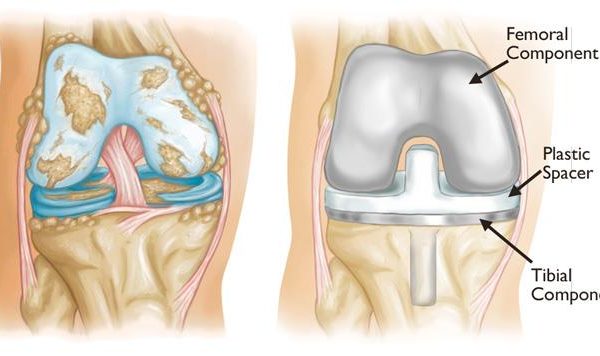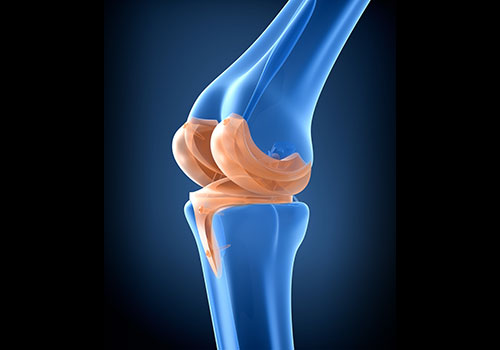The knee is a hinge joint which grants motion at a position where the thigh meets the lower leg. Knee replacement surgery or arthroplasty is a surgical procedure to rectify the knee damaged due to arthritis. Metal and plastic parts are used to cap the ends of the bones that form the knee joints, along with a prosthetic kneecap for support.
The knee is a hinge joint which grants motion at a position where the thigh meets the lower leg. Knee replacement surgery or arthroplasty is a surgical procedure to rectify the knee damaged due to arthritis. Metal and plastic parts are used to cap the ends of the bones that form the knee joints, along with a prosthetic kneecap for support.
What Causes Knee Joint Disorders:
Various kinds of arthritis are the reason that causes deformation of the knee joint, here are some arthritic conditions for your awareness.
- Osteoarthritis is a degenerative joint disease that causes the breakdown of cartilage and adjacent bone in the knees.
- Rheumatoid arthritis causes inflammation of the synovial membrane and results in excess of synovial fluid, it induces pains and stiffness.
- Traumatic arthritis is an arthritic condition caused due to injury, it causes damage to the cartilage of the knee.
Knee Replacement Surgery Procedure:

The thigh-bone (or femur) joins the large bone of the lower leg (tibia) at the knee joint. During total knee replacement, the end of the femur bone is replaced with a metal shell. The end of the lower bone is removed and replaced with a channeled plastic piece with a metal stem. Depending on the condition of the kneecap portion of the knee, a button may be added under the kneecap surface. The artificial components or prosthesis will restore the movement of the knee joint and will completely cure the stiffness and pain of patients.
The posterior cruciate ligament is a tissue that supports each side of the knee-joint so that the lower leg won’t slide back to the thigh-bone. While doing total knee replacement surgery, this ligament is either retained, sacrificed, or replaced by a polyethylene post. Each one of these various designs of total knee replacement has its individual particular benefits and risks.
Post Surgery Measures

Total knee replacement usually requires one-and-a-half to three hours of operation time. Post-surgery patients are shifted to a recovery room, where the vital organs are regularly monitored.
When stabilised, patients are returned to their hospital room. In the postoperative period, the passage of urine will be difficult, so a catheter would be inserted into the urethra to allow free passage of urine until the patient becomes more mobile.
Physical therapy is a very important part of rehabilitation and requires complete participation of the patient for their optimal recovery. Patients can start doing therapy sessions 48 hours after surgery.
Patients can expect some degree of pain, discomfort, and stiffness during the early days of physical therapy. Knee immobilizers are utilized to stabilize the knee while undergoing physical therapy, walking, and sleeping. They may be removed under the guidance of the physical therapist during various portions of physical therapy.
Precautions Patients Should Consider After Discharge
For optimal recovery, patients should undergo a physical therapy program along with home exercises during the healing process. The physio will consult patients to continue exercising the muscles around the replaced joint to prevent scarring(and contracture). It helps to maintain muscle strength for joint stability. Exercises after surgery decrease recovery time and enhance optimal strength along with stability.
The surgeon will examine the wound for healing. Patients should also be careful to warning signs of infection, including abnormal redness, increasing warmth, swelling or unusual pain. It is important to report to the doctor if any injury to the joint occurs.
Extensive sports like running or contact sports should be avoided. Leisure sports like golf, swimming is considered ideal. Such sports improve muscle strength and endurance exerting no pressure or stress to the replaced joint.
Patients thereafter must alert their doctors and dentists that they have an artificial joint. These joints can risk bacterial infections if they are introduced by any invasive procedures, and infections from elsewhere in the body or from surgery, dental or gum procedures, urological and endoscopic procedures.
A physician will prescribe antibiotics before, during and after any elective procedures to prevent infection of the replaced joint. At rare instances, patients with total knee replacements may require a second operation, years later. The second operation would become necessary due to loosening, fracture or other complications.
Little flower hospital and research centre is recognized as one of the best knee replacement surgery hospitals in Kerala. They provide the best medical services for ortho related conditions and disorders.
To know more about clinical therapy for knee and joint therapy click here —>The best knee replacement hospital in Kerala.
.


No comments yet.